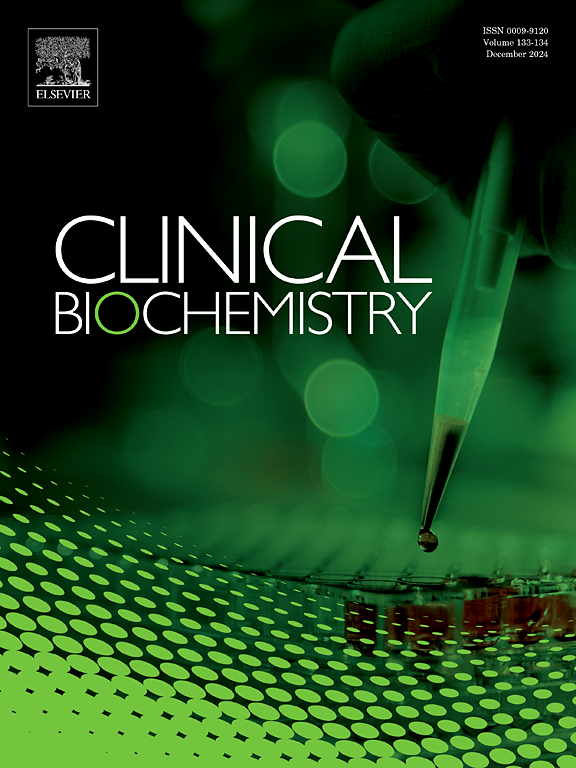Diagnostic value of serum TSI levels in Graves’ disease and direct comparison of diagnostic performance with TRAb: A systematic review and meta-analysis
IF 2.1
3区 医学
Q2 MEDICAL LABORATORY TECHNOLOGY
引用次数: 0
Abstract
This study aimed to systematically assess the diagnostic value of thyroid-stimulating immunoglobulin on the Siemens Immulite platform (the TSI assay) and to conduct a direct comparison with thyrotropin receptor antibodies on the Roche cobas platform (the TRAb assay) for the diagnosis of Graves’ disease (GD). We performed systematic literature searches across multiple databases. Following strict screening, we identified 20 eligible clinical studies that evaluated the diagnostic value of the TSI assay, either alone or in comparison with the TRAb assay. Using random-effects models, we calculated pooled estimates of sensitivity (SEN), specificity (SPE), positive likelihood ratio (PLR), negative likelihood ratio (NLR), and diagnostic odds ratio (DOR). Diagnostic accuracy was further evaluated through summary receiver operating characteristic curve analysis. The findings revealed that the TSI assay demonstrated excellent diagnostic accuracy, with pooled SEN of 0.933 (95 % CI: 0.924 − 0.941), SPE of 0.961 (95 % CI: 0.956 − 0.964), PLR of 24.078 (95 % CI: 16.727 − 34.659), NLR of 0.036 (95 % CI: 0.020 − 0.066), and DOR of 778.29 (95 % CI: 343.45 − 1763.67), supported by an area under the curve (AUC) of 0.9919. In direct comparison to the TRAb assay, the TSI assay showed slightly better SEN (0.967 vs. 0.889), DOR (1310.03 vs. 692.73), and NLR (0.023 vs. 0.046), comparable SPE (0.964 vs. 0.959) and PLR (29.954 vs. 30.066), and higher AUC (0.9963 vs. 0.9899). These results conclusively demonstrate that the TSI assay shows high sensitivity and specificity in the diagnosis of GD, exceeding or at least comparable to TRAb, making it a valuable tool for clinical diagnosis.
血清TSI水平对Graves病的诊断价值及其与TRAb诊断效果的直接比较:一项系统综述和荟萃分析
本研究旨在系统评价促甲状腺免疫球蛋白在Siemens Immulite平台(TSI法)上的诊断价值,并与Roche cobas平台(TRAb法)上的促甲状腺激素受体抗体对Graves病(GD)的诊断价值进行直接比较。我们在多个数据库中进行了系统的文献检索。经过严格筛选,我们确定了20项符合条件的临床研究,评估TSI检测的诊断价值,无论是单独使用还是与TRAb检测进行比较。使用随机效应模型,我们计算了敏感性(SEN)、特异性(SPE)、阳性似然比(PLR)、阴性似然比(NLR)和诊断优势比(DOR)的汇总估计。通过综合受试者工作特征曲线分析进一步评价诊断准确性。结果表明,TSI法具有良好的诊断准确性,其综合SEN为0.933 (95% CI: 0.924 ~ 0.941), SPE为0.961 (95% CI: 0.956 ~ 0.964), PLR为24.078 (95% CI: 16.727 ~ 34.659), NLR为0.036 (95% CI: 0.020 ~ 0.066), DOR为778.29 (95% CI: 343.45 ~ 1763.67),曲线下面积(AUC)为0.9919。与TRAb法直接比较,TSI法的SEN (0.967 vs. 0.889)、DOR (1310.03 vs. 692.73)、NLR (0.023 vs. 0.046)、SPE (0.964 vs. 0.959)和PLR (29.954 vs. 30.066)略好,AUC (0.9963 vs. 0.9899)更高。这些结果最终表明,TSI检测在诊断GD方面具有很高的敏感性和特异性,超过或至少与TRAb相当,使其成为临床诊断的有价值的工具。
本文章由计算机程序翻译,如有差异,请以英文原文为准。
求助全文
约1分钟内获得全文
求助全文
来源期刊

Clinical biochemistry
医学-医学实验技术
CiteScore
5.10
自引率
0.00%
发文量
151
审稿时长
25 days
期刊介绍:
Clinical Biochemistry publishes articles relating to clinical chemistry, molecular biology and genetics, therapeutic drug monitoring and toxicology, laboratory immunology and laboratory medicine in general, with the focus on analytical and clinical investigation of laboratory tests in humans used for diagnosis, prognosis, treatment and therapy, and monitoring of disease.
 求助内容:
求助内容: 应助结果提醒方式:
应助结果提醒方式:


